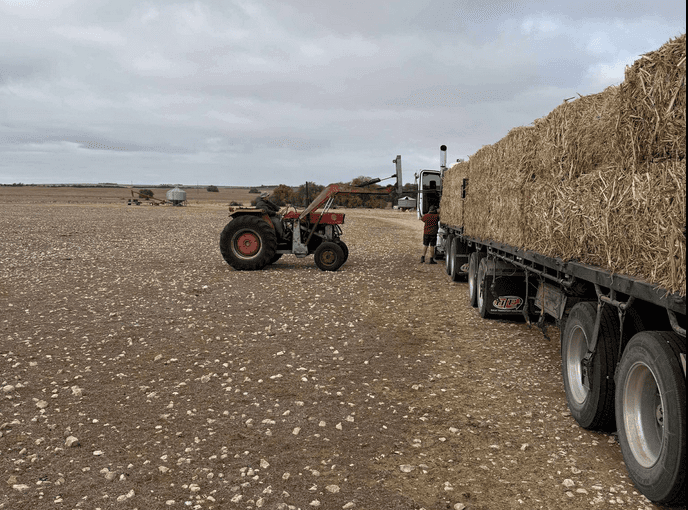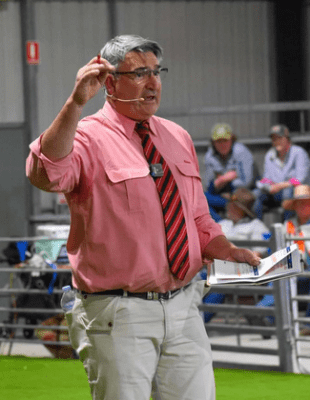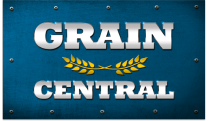
A recent fodder drop in drought-stricken SA. Photo: Need for Feed
SOUTH Australia’s next round of fodder drops is set to take place in early June, as producers prepare to further reduce breeder numbers unless rain arrives in time to spark pasture growth before winter sets in.
The fodder situation is equally dire in much of western Victoria, and has also become serious in southern New South Wales, although stored hay and grain and agistment options in central and northern NSW and in Queensland have arguably made the Vic and NSW situations less acute.
Stemming the flow of hay into SA over recent months has been the impact of March and April flooding in Qld and north-west NSW.
Sources say SA Government fodder freight subsidies in recent months lagged those being offered by the Qld and NSW governments.
The upshot has been that donated hay landing in SA fell away in recent months, but will rebuild in response to the autumn break failing to eventuate thus far, and SA Government support for charity drops.
SA Govt beefs up program
In a statement, the SA Government said its initial $2M investment in charity hay runs enabled more than 4200t of hay to be delivered to 436 primary producers across drought-affected regions of SA.
On May 1, an extra $4M was pledged through the Donated Fodder Transport Drought Assistance Scheme, calculated from the point of origin at a rate per loaded kilometre of $4.50 for single trailers, $7.50 for B-doubles, and $9 for road trains.
“The different tiers are due to larger trucks requiring more fuel to travel the same distance, and these rates are consistent with other states’ schemes for natural disaster responses,” the statement said.
“‘If there are particular circumstances that necessitate a higher rebate, charities can submit alternative proposals for consideration.
“Feedback from producers and charities has shaped this new scheme so support is targeted to the areas most in need and the fodder is fit for purpose.”

Trail-feeding barley to Merino ewes ahead of lambing next month at Wudinna on Upper Eyre Peninsula. The Lynns have bought two road-train loads of straw, and 50t of barley, to supplement their own grain, hay and straw supplies being used to feed ewes and lotfeed lambs through the drought. Photo: Leanne Lynn
Not without critics
In Qld, freight subsidies of up to $5000 per non-drought disaster event are available for eligible primary producers, but not agents, charities, or not-for-profits.
The Qld Government subsidy rate for hired carriers is either half the loaded portion of the transport cost, or 13c/km per tonne, whichever is the lower amount, and to receive the full subsidy, must come from within 1000km.
Under NSW legislation, organisations that transport donated fodder for the benefit of three or more primary producers whose properties have been affected by a natural disaster can apply to have transport costs over up to 1500km reimbursed.
The SA Government’s freight subsidy appears to have failed to land donated hay west of SA’s Mid North, with drought-stricken graziers and mixed farmers on Eyre Peninsula looking at round trips of 600-1000km to collect from fodder drops.
Representatives of Livestock SA last week met with SA Government officials to discuss support available to drought-affected producers, including subsidies to get fodder on to farms.
“We are currently looking at seeing if there can be transport subsidies for those trying to maintain breeding stock,” Livestock SA communications and membership manager Hannah Trevilyan said.
Anecdotal evidence points to many SA producers having halved breeder numbers already, with a further reduction likely in coming weeks unless it rains.
Livestock SA members are invited to complete a short survey to indicate what level of breeding stock they are currently running as compared to normal, their expenditure on drought fodder and/or agistment over the past 12 months, and distance over which they are trucking fodder.
The responses will be used to help shape Livestock SA’s requests to government about how its members can best be helped through what for many is the worst drought in living memory.
In a statement, SA Shadow Minister for Primary Industries Nicola Centofanti has criticised the SA Government’s freight subsidy scheme.
“We absolutely support a level playing field when it comes to ensuring fodder is delivered for South Australian farmers,” Dr Centofanti said.
“My office has heard from many desperate farmers who have missed out on vital feed for their stock because the lack of freight subsidies from this government.
“Not only is the subsidy too low, but the red tape to access it is beyond a joke, meaning some charities are no longer dealing with our state authorities, leaving farmers high and dry.
“The harsh reality is that hard-working South Australian farmers are teetering on the edge, doing everything they possibly can to survive; they need this critical hay to be delivered to keep their stock going.”
Hay coming to Gladstone, Jamestown
At least two charities, the Lions Club’s Need for Feed and the Plymouth Brethren Christian Church’s Rapid Relief Team, are planning fodder drops next month.
Need for Feed chair Graham Cockerell said their drop, pencilled in for Gladstone in the Mid North on the King’s Birthday long weekend, will be its tenth into SA since December 2023.
Mr Cockerell said Gladstone has proven a good hub for trucks distributing to other districts.
“Not everywhere can you pull up 30-something trucks, especially when some are road trains.”
Mr Cockerell said most of the hay will be coming out of central NSW, and will be bought rather than donated, following volume gifting and sales of hay into the vast flooded regions of Qld, and NSW to a lesser extent, in recent months.
“There are not many donations now.”
Mr Cockerell said the latest SA Government package has been welcomed.
“We’ve got a new agreement with the SA Government now, and transport for our trip in December was fully covered, and the January one was mostly covered.”
Need for Feed has also been putting loads of hay into western Vic, where Mr Cockerell said drought demand was ongoing.
Rapid Relief Team is planning to truck 1500 bales of cereal hay from Qld and NSW to Jamestown in SA’s Upper North for collection on June 6 at its latest Farmers Community Connect event.
“Farmers across parts of SA have been doing it tough as the drought conditions continue to impact their lives and livelihoods, and we hope this event will bring them a little relief during this difficult time,” RRT director Mick Dunn said.
The June delivery is expected to involve 23 Rapid Relief Team trucks.
“As well as free hay, farmers will have access to local service providers with a range of support available, and of course we’ll be firing up the RRT barbecue and cooking up bacon and egg rolls and signature burgers for those who attend.
“We’re all in awe of the resilience of our farmers but this drought is more severe than many people realise.”
RRT is receiving $195,000 from the SA Government to fund the transportation of the fodder, and estimates it will contribute more than $250,000 to pay for hay, catering, and volunteer expenses.
In November, RRT fully funded the transportation and donation of 250t of feed distributed from Mannum to 169 farmers.
Alongside Need for Feed and RRT, Rural Aid and Farmers Relief Agency, have also worked with the SA Government to get fodder to farms in need, with the SA Dairyfarmers’ Association is authorised to receive support for dairy cattle only.
Rural Aid has already delivered fodder to producers in the Murray-Mallee and Mid North, and is planning further drops to locations as far west as Petina and Cleve on Eyre Peninsula.
“This is a tentative plan, as we continue to respond to the significant demand for fodder from farmers in South Australia,” Rural Aid advised in a statement.
“The farmers identified have been on a waiting list, and hay allocations are made in advance of transport planning to ensure an equitable and efficient process.
“We’re currently working with a few different suppliers, so the type of trucks and hay may vary, though at this stage, most loads are expected to consist primarily of large square bales of oaten and wheaten hay.
Restocker, processor support
Elders Keith-based state livestock sales manager for southern SA Laryn Gogel said where to source fodder was “a pretty hot topic”.

Elders agent Laryn Gogel.
“As we continue with the dry, most of the people I know are trying to source their own fodder, and trying to keep hay in their sheds and grain in their silos,” Mr Gogel said.
“We’ve been able to draw a lot from close to home, and as times have gotten tougher, we’re calling on cropping areas that didn’t have great a year themselves, like Yorke Peninsula.”
Mr Gogel said most producers have been “proactive” about cutting stock numbers and sourcing feed since early last year, when dry conditions set in.
“A dry ewe or cow has gone early, we’ve sold a lot of spring-drop calves early, and feeder-weight steers are well and truly sold.
“We’re in the next round now; speaking to a few people last week, if we don’t get rain before the end of June, they’ll be weaning autumn-drop calves early.”
The South East’s break normally shows up by May 10-12, and Mr Gogel said its residents were “all aware of nothing on the horizon” from weather forecasts extending into June.
He said strong sheep and cattle prices brought about by northern restocker demand, and strong beef and sheepmeat export markets, have been a blessing.
“Even with the big sell-off of cattle, we still seem to find homes for everything we’ve got to sell.
“I believe we’re lucky it’s rained somewhere.”
That somewhere is Qld and northern NSW.
“We’ve seen a lot of our livestock head that way.”
Processor demand has also been solid.
“We’ve been watching huge volumes of red meat leave our shore month after month, and we’re very blessed to have processors active who are helping to supply that.”
Grain Central: Get our free news straight to your inbox – Click here

HAVE YOUR SAY